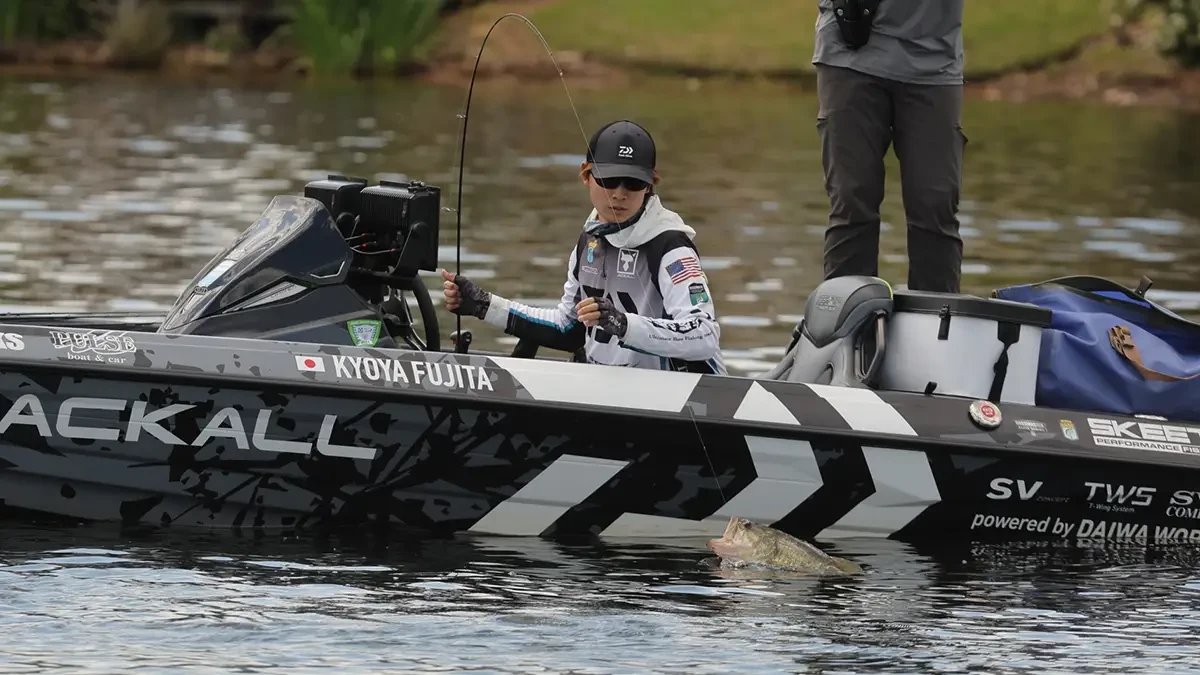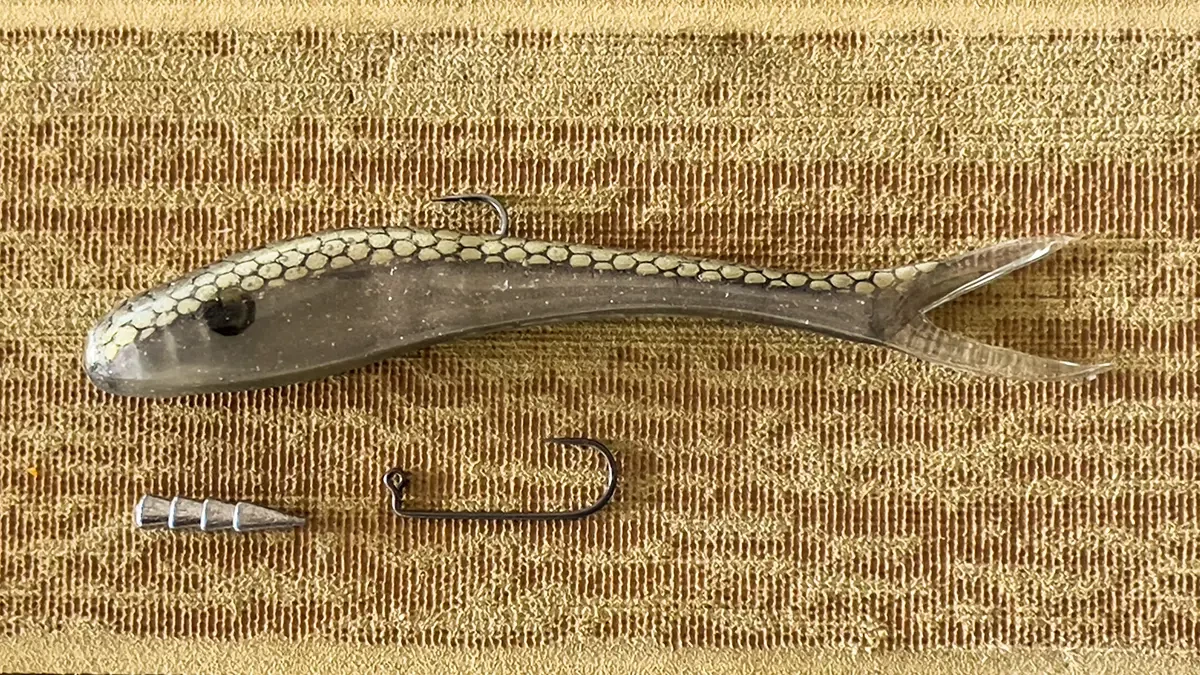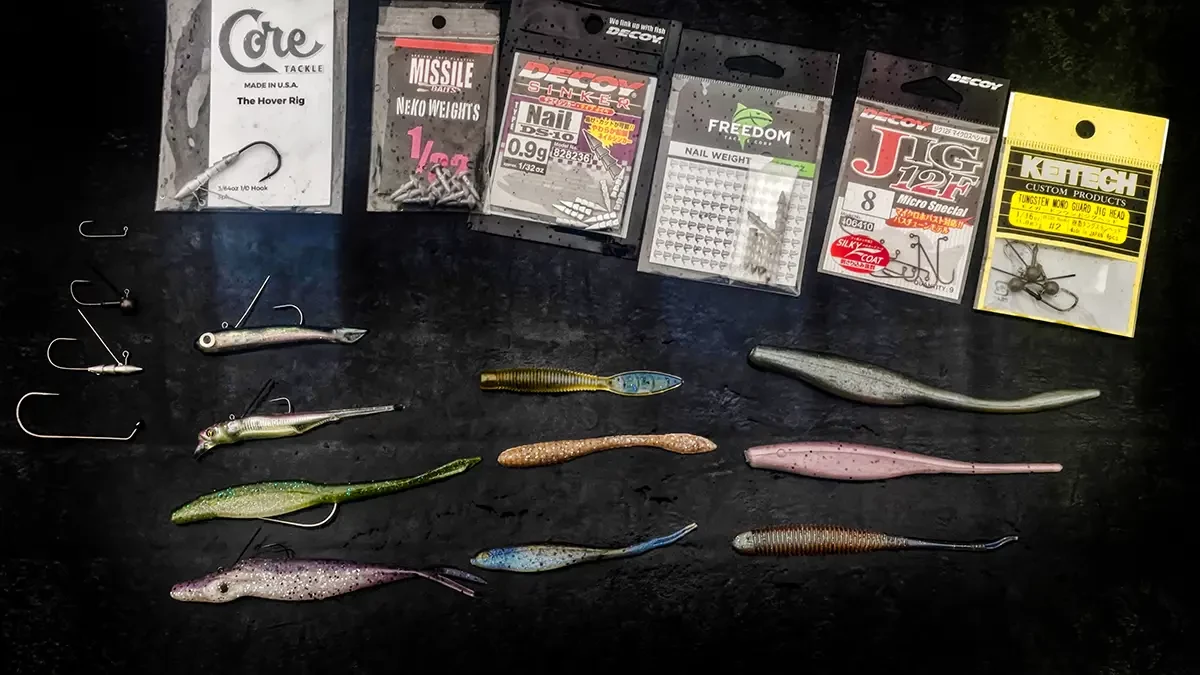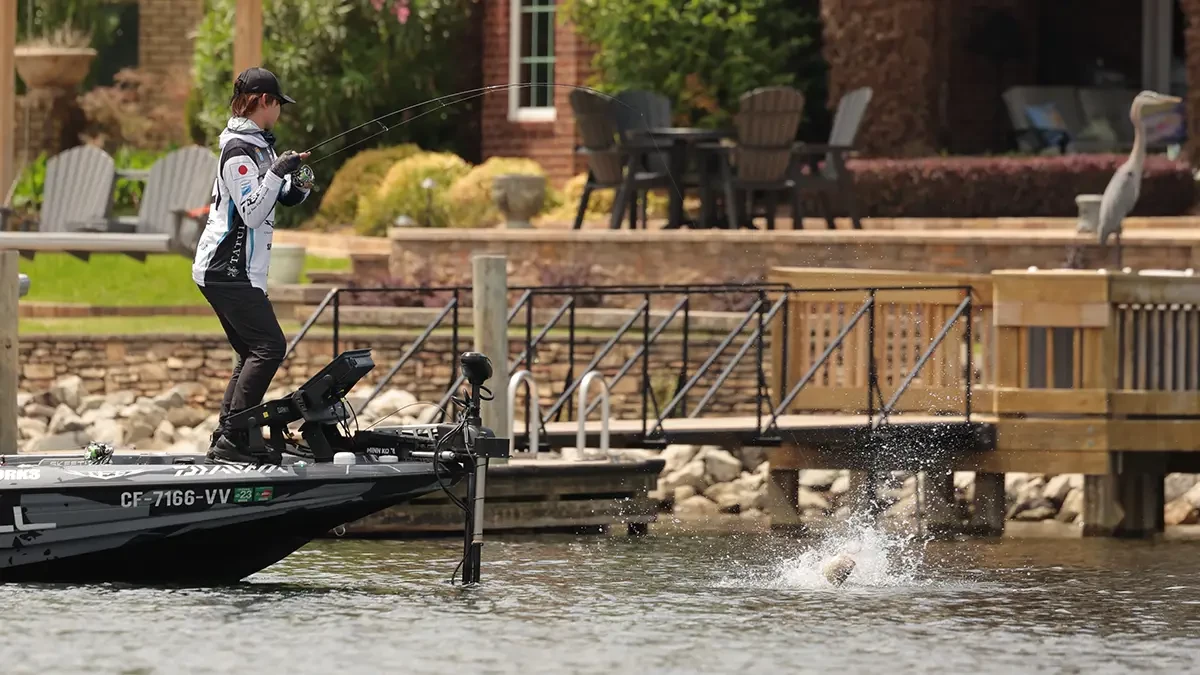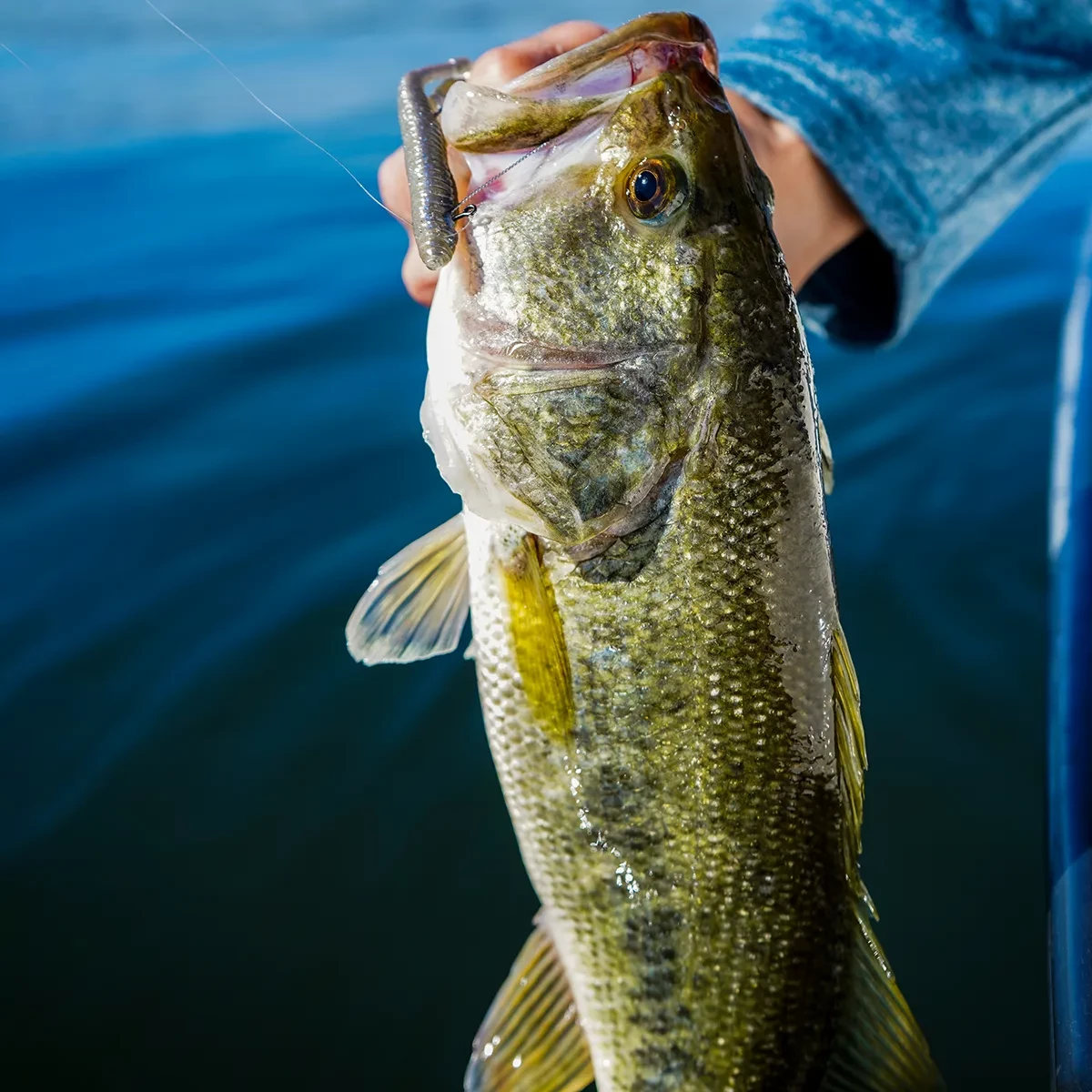Mark my words, hover strolling is the next big thing in bass fishing. At least for now anyways. This finesse tactic has been slowly spreading through the die-hard bass community for more than a year now, but it’s really gaining traction and about to blow up with the fishing community.
Just last week, we saw Bassmaster Elite Series rookie Kyoya Fujita, 4-time Japanese Angler of the Year, hover stroll his way to a third place finish on Lake Murray. It’s apparently been a weapon in the arsenal of Japanese anglers like Fujita for quite some time now, but it’s still a relative unknown to the masses.
A few of the pros have talked about it off and on over the last year or two. A bunch of co-anglers have already mastered it. Yet, it’s still being kept a secret by a lot of anglers. Whether you see it mentioned as spine rigging, hover shotting, or hover strolling, this rig is worth learning and fishing. So let’s start be defining and explaining hover strolling, and then, we’ll delve into terminal tackle, bait selection, when and where to fish it and more.
Basic idea of hover strolling
Before explaining how to setup the hover strolling rig (since there are multiple ways to do so), it’s better to start with the hole in bass fishing that the tactic plugs.
Suspended bass can be some of the hardest to bass to catch. We’ve known that for years. But with the advent of forward facing sonar, we can now see these fish all over and still have a hard time getting them to bite. So new techniques have been created and continuously evolving to target these fish.
With the hover strolling rig, you can present a light-weight soft plastic lure to a suspended bass, or one on the bottom, and work the bait slowly while keeping it at the same level. Other baits, like spy baits, jerkbaits and finesse swimbaits, can all be kept on a fairly level course through the water column as well, but they have to be reeled at a constant speed or aggressively worked to achieve this.
This is where the hover strolling technique comes in. Using this method, a soft plastic lure can be twitched back and forth slowly, at the same position in the water column as the fish. So think walking a weightless Fluke along the surface in terms of action, but being able to do this several feet below the surface.
The traditional hover strolling rig
This technique is still new, in fact, so new, that terminal tackle and soft baits are being developed for it as we speak. But the most common way to setup a hover strolling rig involves a nail weight, a soft plastic lure and a hook with a 90-degree offset eye.
First, take the hook in one hand and the soft plastic in the other, insert the hook 1/4- to 1/2- inch behind the nose of the bait, depending on the size of the soft plastic and hook. This leaves room for the tungsten weight. Then thread the bait up onto the hook and pop the hook point out of the back of the bait, with a straight bait being the end goal, similar to how you would rig a Ned rig.
At this point, you should have a straight soft plastic threaded onto the hook with the point coming out of the midsection of the back of the bait and the line tie eye sticking up out of the top of the head of the bait, a short distance behind the nose. Now, take a nail weight and insert it into the nose of the bait and you have successfully assembled a hover strolling rig.
Hover Strolling Tackle Options
There are a ton of hover strolling terminal tackle options as well as a plethora of soft plastics to put on them. Some guys like the nail weight and jig hook. Some guys like a jighead (specialized or tungsten ball head). Still some guys like a weed guard and some guys don’t. So there is still a lot of personal preference around the technique.
But here’s a few the hooks, jigheads, and plastics we recommend based on our own experiences and talking with a bunch of anglers who are already very good with the technique.
Terminal Tackle for Hover Strolling
- Core Tackle Hover Jig
- Fish Arrow Spine Hook
- Ryugi Hover Shot Hook
- Keitech Mono Guard Jig Head
- Decoy Micro Special Hover Strolling Hook
- Decoy Worm Hover Shot Hook
- Ark Fishing No Chip Tungsten Nail Weights
- Freedom Tackle Tungsten Nail Weights
Soft Bait Recommendations for Hover Strolling
- Jackall RV Drift Fry
- Fish Arrow Flash J Split Tail Shad
- Basstrix Flash Trix
- Berkley Flatworm
- Strike King Caffiene Shad
- Yamamoto D Shad
- Xcite X-Shad
- NetBait STH BaitFuel Flat Sided Shad
- Missile Baits Ned Bomb
New hover strolling jigheads
Professional fisherman Matt Stefan has been fishing the hover strolling technique for a little over a year now and has been amazed by its effectiveness. So much so in fact, that he and Johnny Schultz launched the Hover Rig as the first item in their new Core Tackle company to design what they believe is a much better system.
“Basically, we took the 90-degree jig hook that people would use for traditional hover strolling and we molded a nail weight onto it,” said Stefan.
Creating one piece of terminal tackle, which they aptly named The Hover Rig, solved lots of issues for Stefan. One of the main ones being terminal tackle attrition. With the traditional way of rigging, almost every fish catch resulted in a lost nail weight, torn soft plastic or both for Stefan. Not so with The Hover Rig.
“We kept the weight positioned so that there’s a point coming off the front of it. That does two things. It allows for the exact same weight transfer that the nail weight gave. And it locks the bait in place, so it acts as a bait keeper.”
“I’m not joking when I say, if I caught 10 fish before, that meant I’d go through a pack of baits and a pack of nail weights. Now, however, with the Hover Jig, it’s not uncommon to catch 10 fish on one bait.”
The Hover Rig also comes with a weedguard built in. This makes the rig much more weedless as compared to the traditional way of rigging, which opens up all new options when it comes to the cover anglers can now target with this technique.
How to hover stroll
This rig can be used at a wide range of depths and with a massive assortment of soft plastics. Though soft plastic jerkbaits and forked tail swimbaits are the frontrunner when it comes to targeting suspended fish.
“It really shines when you’ve got fish that are suspended up in the water column, because it’s such a light and slow falling bait that it triggers those fish that are suspended.”
The slow fall isn’t really what sets this rig apart though. That could be accomplished with a Fluke rigged on a belly-weighted hook for instance. It’s more about keeping the bait at the same level in the water column. A belly-weighted Fluke shoots upward when it’s twitched. The hover strolling rig shoots side to side.
“That’s one of the keys to it, is the 90-degree hook eye and the placement of it being behind the head of the bait. When you give your rod tip a twitch, it imparts an extremely erratic action to the bait. So instead of it coming at you, it’ll actually gives you a quick dart to the left or to the right.”
Knowing this, you can cast a bait out, let it fall on semi-slack line and then begin to work the bait whenever it reaches the desired depth.
“If you want to keep it above the fish, you can do that really easily by picking up some slack and kind of giving it a quick couple of twitches. And that bait will do a really good job of almost suspending in the water column.”
The hover strolling technique isn’t only for suspended fish however. It works well along the bottom too.
“I personally like to throw it in areas where I use more of a Ned rig. I feel like the Ned rig pretty much falls with a straight vertical fall, but with the hover strolling technique you get a really erratic fall, gliding and spiraling a lot like a tube jig. And from that standpoint it’s really replaced the Ned rig more for me than anything.”
When not to use it
Stefan cautions that this isn’t a be-all and end-all way of fishing. It’s just another tool, albeit an extremely effective one, to add to the savvy angler’s ever expanding arsenal. It does what it does well, but it’s not a bait for covering water for example.
“If you know there are fish around, like if you see them on Active Target and you cast at them, it’s a really good bait to trigger them to strike. It’s not a search bait.”
Stefan recommends sticking with a finesse swimbait for example when wanting to cover water and locate fish. Hover strolling is a much more methodical and target oriented way of fishing that takes time to execute.
“When I say it’s a slow bait to throw, it’s kind of like a weightless wacky rig. If you’re throwing it at a target that you feel confident in, you’re willing to give it some more time and be patient with the bait. So when you feel confident you’re around fish, it’s a great way to trigger them to strike.”
Experienced Secrets
Stefan’s favorite way to fish the hover strolling rig is right along the bottom, because that is the best way he’s found to take advantage of its truly unique action.
“If you let that bait fall to the bottom and then give it one quick twitch, it’ll shoot like a crayfish almost, two or three feet. But it won’t come high in the water column. It’ll stay on the bottom.”
Leaving a little of the weight sticking out of the nose will also do a couple things. The metal weight creates a little sound as it collides with hard cover along the bottom. And leaving the tip of the weight exposed will also increase sensitivity, especially using the Core Hover Rig.
“I think you get more sensitivity with our hook, being that the weight is connected to the hook. There’s a better transfer there than with a separate nail weight and hook.”
Wired2fish Publisher Jason Sealock has been fishing the hover strolling method a bunch lately and he has liked it with a traditional jerkbait as well as with smaller baits like the Basstrix Live Trix.
“I’ve fished it both ways with a jig hook and nail weight and with jigheads like the Keitech ball head and the Core Tackle Hover Shot jighead. Both are dynamite. But I’ve had most of my success twitching it along with BFS gear. Light line on a bait finesse baitcasting setup has been a lot of fun.
“I’ve been catching bedding smallmouth and largemouth that are too deep to see with my eyes, but I can see the depressions on Livescope, and I get them to show themselves by reeling the hover strolled shad bait slowly with a slight rod twitch. It makes the jerkbait or shad bait twitch back and forth. Almost like it’s wobbling or really swimming.
“Most of the time the pick up is light. You just feel tension, and with this rig, you just have to lean into them, and they are hooked. While the hooks are tiny, they hold really well.”
Future of Hover Strolling
The hover strolling system is still new to a lot of anglers, but those that have been doing it a while are employing it with different retrieves and plastics. We’ve seen a lot of success recently with guys swimming it with continuous twitches.
It was a player in the recent Toyota Series on Kentucky Lake. It was a player in the Elite Series on Murray. It will become more of a player as we get into summer with suspending fish and smallmouth tournaments.
“It’s very much a quiet finesse presentation right now,” Stefan said. “But I think we’re going to see it become more of a mainstream presentation with added power versions as well.”
Stefan recently used a larger prototype version of the Hover Rig to target bass on Lake Eufaula.
“At my last tournament, I finished 21st, and I was pretty much flipping a 3/0 hook with an 1/8-ounce version with a MaxScent Creature Hawg. I was flipping around laydowns and I caught the majority of my fish doing that.”
In an effort to apply this weight transfer concept to bigger baits, Stefan’s Core Tackle is building jigheads to reach deeper depths and present something new to heavily pressured big bass on lakes like Guntersville and Chickamauga.
“We just approved a prototype in terms of putting into production a 5/0 hook with a 1/4-ounce weight that we’re calling our Ledge Hover, specifically for that.”
Stefan has poured a lot of time and energy into the research and development of terminal tackle for this technique. But he’s also acknowledges the interest and efforts of other anglers and companies as well.
“I think a lot of us are just kind of scratching the surface on this technique. We’re seeing a lot of companies coming out with product. Our hook’s been out for two months, and we can’t keep them in stock.
“People are catching a ton of fish on it. And I don’t just mean our hook; I mean the presentation. People are really falling in love with it because it is an easy presentation to fish and it catches them.”



